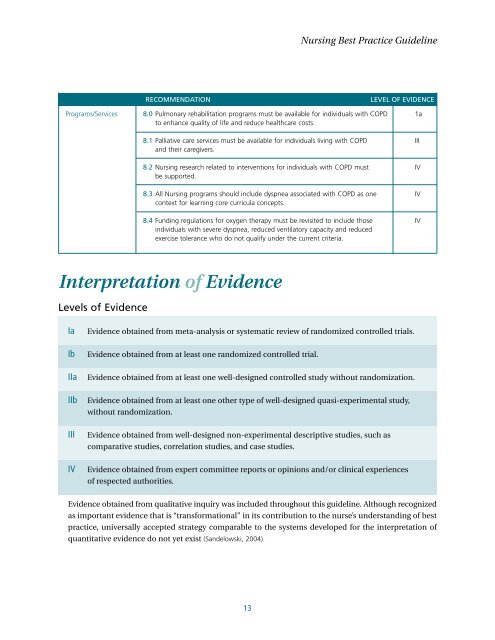Nursing Care of Dyspnea: The 6th Vital Sign in Individuals with ...
Nursing Care of Dyspnea: The 6th Vital Sign in Individuals with ...
Nursing Care of Dyspnea: The 6th Vital Sign in Individuals with ...
Create successful ePaper yourself
Turn your PDF publications into a flip-book with our unique Google optimized e-Paper software.
<strong>Nurs<strong>in</strong>g</strong> Best Practice Guidel<strong>in</strong>eRECOMMENDATIONLEVEL OF EVIDENCEPrograms/Services 8.0 Pulmonary rehabilitation programs must be available for <strong>in</strong>dividuals <strong>with</strong> COPD 1ato enhance quality <strong>of</strong> life and reduce healthcare costs.8.1 Palliative care services must be available for <strong>in</strong>dividuals liv<strong>in</strong>g <strong>with</strong> COPD IIIand their caregivers.8.2 <strong>Nurs<strong>in</strong>g</strong> research related to <strong>in</strong>terventions for <strong>in</strong>dividuals <strong>with</strong> COPD must IVbe supported.8.3 All <strong>Nurs<strong>in</strong>g</strong> programs should <strong>in</strong>clude dyspnea associated <strong>with</strong> COPD as one IVcontext for learn<strong>in</strong>g core curricula concepts.8.4 Fund<strong>in</strong>g regulations for oxygen therapy must be revisited to <strong>in</strong>clude those IV<strong>in</strong>dividuals <strong>with</strong> severe dyspnea, reduced ventilatory capacity and reducedexercise tolerance who do not qualify under the current criteria.Interpretation <strong>of</strong> EvidenceLevels <strong>of</strong> EvidenceIaIbIIaIIbIIIIVEvidence obta<strong>in</strong>ed from meta-analysis or systematic review <strong>of</strong> randomized controlled trials.Evidence obta<strong>in</strong>ed from at least one randomized controlled trial.Evidence obta<strong>in</strong>ed from at least one well-designed controlled study <strong>with</strong>out randomization.Evidence obta<strong>in</strong>ed from at least one other type <strong>of</strong> well-designed quasi-experimental study,<strong>with</strong>out randomization.Evidence obta<strong>in</strong>ed from well-designed non-experimental descriptive studies, such ascomparative studies, correlation studies, and case studies.Evidence obta<strong>in</strong>ed from expert committee reports or op<strong>in</strong>ions and/or cl<strong>in</strong>ical experiences<strong>of</strong> respected authorities.Evidence obta<strong>in</strong>ed from qualitative <strong>in</strong>quiry was <strong>in</strong>cluded throughout this guidel<strong>in</strong>e. Although recognizedas important evidence that is “transformational” <strong>in</strong> its contribution to the nurse’s understand<strong>in</strong>g <strong>of</strong> bestpractice, universally accepted strategy comparable to the systems developed for the <strong>in</strong>terpretation <strong>of</strong>quantitative evidence do not yet exist (Sandelowski, 2004).13
















